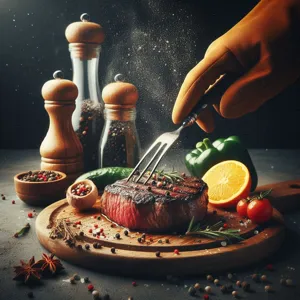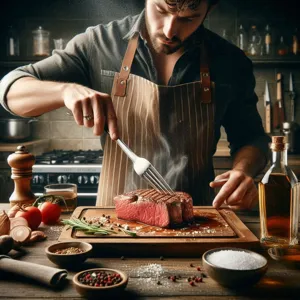There’s something undeniably satisfying about a perfectly cooked steak—the way it sizzles on the grill, the tantalizing aroma that fills the air, and that first succulent bite that melts in your mouth.
Whether you’re a seasoned grill master or a novice cook eager to impress, mastering the art of steak is a culinary journey worth embarking on. In this ultimate guide, we’ll delve into the secrets of selecting the finest cuts, understanding the ideal cooking techniques, and infusing flavors that elevate your steak to gourmet status. From the importance of resting your meat to the nuances of seasoning, every detail matters in achieving that perfect sear and juicy interior. Get ready to elevate your cooking skills and transform your kitchen into a steak lover’s paradise, as we unlock the keys to creating the perfect cut that will leave your family and friends craving more!
1. Understanding Different Cuts of Steak

To master the art of cooking steak, the first step is to understand the different cuts available and what makes each one unique. Each cut comes from a specific part of the cow, and this influences not just the flavor but also the texture and cooking method that will yield the best results.
**Tender Cuts**: Cuts like the tenderloin and ribeye are often revered for their buttery tenderness and rich flavor. The tenderloin, also known as filet mignon, is taken from the loin and is the most tender cut of beef. It is lean with a subtle taste, making it ideal for those who prefer a milder flavor profile. The ribeye, on the other hand, comes from the rib section and is marbled with fat, which contributes to its robust, beefy flavor and juicy texture. This cut is particularly popular for grilling and pan-searing.
**Flavorful Cuts**: If you’re looking for a steak that packs a punch in terms of flavor, consider cuts like the sirloin or flank steak. The sirloin comes from the rear of the cow and offers a balance of tenderness and flavor, making it a versatile choice for various cooking methods. Flank steak, meanwhile, is lean and flavorful but can be tough if not cooked properly. It’s best when marinated and cooked at high temperatures quickly, then sliced against the grain to maximize tenderness.
**Budget-Friendly Options**: For those who want to enjoy steak without breaking the bank, cuts like skirt steak and chuck eye steak are excellent choices. The skirt steak, which comes from the diaphragm, is full of flavor and perfect for dishes like fajitas. Chuck eye steak, often referred to as the “poor man’s ribeye,” offers a similar taste profile to ribeye at a fraction of the price, making it a great option for everyday grilling.
**Understanding Marbling and Aging**: Besides the cut, it’s essential to consider marbling—the intramuscular fat that contributes to a steak’s flavor and juiciness. Look for steaks with a good amount of marbling for the best eating experience. Additionally, some steaks undergo dry aging, a process that intensifies the flavor and tenderness by allowing moisture to evaporate from the meat while enzymes break down muscle tissue. Aged steaks are often more expensive but worth the investment for special occasions.
By understanding the unique characteristics of each cut, you can select the right steak for your cooking method and personal taste preferences, setting you on the path to grilling perfection. Whether you’re preparing a cozy dinner for two or hosting a summer barbecue, knowing your cuts will elevate your steak game and ensure a memorable meal every time.
2. Choosing the Right Steak: Grass-Fed vs. Grain-Fed
When it comes to mastering the art of steak, one of the most crucial decisions you’ll make is choosing between grass-fed and grain-fed beef. Each type brings its unique flavor, texture, and nutritional profile to the table, influencing not only the taste of your dish but also the overall dining experience.
Grass-fed beef comes from cattle that graze on grass and forage throughout their lives. This diet leads to meat that is typically leaner, with a distinct, earthy flavor that reflects the natural diet of the animals. Many steak enthusiasts appreciate the robust taste and firmer texture of grass-fed cuts. Additionally, grass-fed beef is often touted for its health benefits, being lower in total fat and higher in omega-3 fatty acids and antioxidants such as vitamin E. However, the trade-off is that grass-fed steaks can sometimes be less tender than their grain-fed counterparts, requiring careful cooking to avoid overcooking.
On the other hand, grain-fed beef, which comes from cattle that are fed a diet rich in grains, usually results in a marbled cut that is tender, juicy, and rich in flavor. The marbling—small flecks of fat interspersed throughout the muscle—melts during cooking, imparting a buttery richness that many people love. Grain-fed beef tends to be more consistent in flavor and tenderness, making it a popular choice for those looking for a classic, indulgent steak experience. However, it’s worth noting that grain-fed beef can often have a higher fat content and fewer beneficial nutrients compared to its grass-fed counterpart.
Ultimately, the choice between grass-fed and grain-fed steak boils down to personal preference and cooking style. Consider what flavors you want to highlight and how you plan to prepare your steak. Whether you opt for the lean, complex notes of grass-fed or the familiar richness of grain-fed, making an informed choice will set the foundation for a truly masterful steak dinner.
3. Essential Tools for Cooking Steak

Cooking the perfect steak is not just about choosing the right cut; it also requires the right tools to elevate your culinary experience. A well-equipped kitchen can make the difference between a good steak and a truly unforgettable one. Here are some essential tools every aspiring steak master should have in their arsenal.
**1. A High-Quality Chef’s Knife:**
Investing in a sharp, durable chef’s knife is crucial for trimming and cutting your steak. A good knife allows for precise cuts, ensuring even cooking and presentation. Look for a knife made from high-carbon stainless steel, which retains its sharpness and provides excellent control.
**2. A Cast Iron Skillet or Grill Pan:**
For an exceptional sear, a heavy cast iron skillet or grill pan is indispensable. These pans provide even heat distribution, allowing you to achieve that coveted crust while sealing in the juices. Preheat your skillet until it’s smoking hot for best results—this is the secret to a perfect steak.
**3. Instant-Read Meat Thermometer:**
Achieving the ideal doneness relies on precise temperature control. An instant-read meat thermometer is a game changer, allowing you to monitor your steak’s internal temperature accurately. For a medium-rare steak, aim for around 130°F (54°C). This tool takes the guesswork out of cooking, ensuring your steak is cooked to perfection every time.
**4. Tongs:**
When it comes to flipping and handling your steak, tongs are your best friend. Unlike forks, which can pierce the meat and release precious juices, tongs allow for gentle maneuvering. Opt for long-handled, heat-resistant tongs to keep your hands safe from splattering oil.
**5. A Good Cutting Board:**
After cooking your steak, it’s essential to let it rest before slicing. A sturdy cutting board will not only provide a stable surface but can also catch all the delicious juices that run off. Look for a board made from hardwood or bamboo, as these materials are gentle on your knife’s edge.
**6. A Quality Marinade or Spice Rub:**
While not a tool in the traditional sense, having a go-to marinade or spice rub is essential for enhancing flavor. Whether you prefer a simple blend of salt and pepper or a more complex marinade, these flavor enhancers can elevate your steak from ordinary to extraordinary.
By equipping yourself with these essential tools, you’ll be well on your way to mastering the art of steak. Each tool plays a vital role in the cooking process, ensuring that your steaks are not only delicious but also cooked to perfection every single time. So, gather your supplies, and get ready to impress your family and friends with mouthwatering steak dishes!
4. The Importance of Temperature: Bringing Steak to Room Temp
When it comes to cooking the perfect steak, one of the often-overlooked yet critical factors is temperature—specifically, the temperature of the meat before it hits the grill or pan. Bringing your steak to room temperature is an essential step that can make all the difference in achieving that mouthwatering, juicy result.
Why is this important? When you cook a steak straight from the refrigerator, the cold center can lead to uneven cooking. The outer layers may char beautifully while the inside remains stubbornly cool and undercooked. By allowing your steak to rest at room temperature for about 30 to 60 minutes before cooking, you’re ensuring that heat penetrates more evenly throughout the cut. This simple adjustment helps to create a more uniform cook, giving you that perfect medium-rare center while achieving a beautifully seared crust.
Furthermore, bringing your steak to room temperature enhances the flavor and texture. The heat from the pan or grill can better interact with the meat fibers, allowing for a more tender bite. This process also aids in maximizing the Maillard reaction— the chemical reaction that creates the savory, complex flavors we all crave in a grilled steak.
To get the best results, take your steak out of the fridge and unwrap it—allowing it to breathe—while you prepare your cooking setup. This time can also be used to season your steak generously with salt and pepper, allowing the seasoning to penetrate the meat as it warms.
Remember, patience is key. While it may be tempting to rush into cooking, taking a moment to let your steak acclimate to room temperature can elevate your steak game to new heights, ensuring each bite is as delightful as the last.
5. Seasoning Your Steak: Simple But Effective Techniques

When it comes to cooking the perfect steak, seasoning is not just an afterthought; it’s an essential step that can elevate your dish from ordinary to extraordinary. While the quality of the meat is paramount, the right seasoning can enhance its natural flavors and create a mouthwatering crust that will have your guests coming back for seconds. Here are some simple but effective techniques to master the art of seasoning your steak.
**1. Keep It Simple:** The most classic approach to seasoning steak is to use just salt and pepper. A generous sprinkle of coarse sea salt and freshly cracked black pepper is often all you need to let the rich flavors of the meat shine through. The salt helps to draw out moisture and enhance the steak’s inherent taste, while the pepper adds a subtle heat that complements the overall profile.
**2. Use the Right Timing:** Timing is crucial when it comes to seasoning. For maximum flavor, it’s best to season your steak at least 30 minutes before cooking. This allows the salt to penetrate the meat, resulting in a more flavorful and juicy steak. If you’re short on time, season right before cooking, but avoid adding salt too far in advance, as it can draw out moisture and lead to a dry steak.
**3. Experiment with Marinades:** If you’re looking to add an extra layer of flavor, consider marinating your steak. A simple marinade can be made with olive oil, vinegar or citrus juice, garlic, and herbs. Allow your steak to soak in this flavorful concoction for at least an hour (or overnight for tougher cuts) to infuse it with deliciousness. Just remember to pat the steak dry before cooking to achieve that coveted sear.
**4. Play with Herbs and Spices:** Don’t be afraid to get creative with your seasonings! Fresh herbs like rosemary, thyme, and parsley can bring a delightful freshness to your steak. Alternatively, spices such as smoked paprika, cumin, or garlic powder can add depth and complexity. Just be mindful not to overpower the steak; a little goes a long way.
**5. Finish with Flavor:** For a gourmet touch, consider finishing your steak with a compound butter or a drizzle of high-quality olive oil right before serving. A pat of herb-infused butter melting over the top adds richness and an enticing aroma that elevates your dish to restaurant-quality status.
In the world of cooking, seasoning is an art form that requires balance and a touch of intuition. By mastering these simple yet effective techniques, you’ll ensure that each steak you cook is bursting with flavor, leaving a lasting impression on everyone lucky enough to share your meal. Happy cooking!
6. Cooking Methods: Grilling, Pan-Searing, and Broiling
When it comes to cooking the perfect steak, the method you choose can make all the difference. Each technique brings its own unique flavor and texture to your meat, so understanding the nuances of grilling, pan-searing, and broiling is essential for any steak enthusiast.
**Grilling** is perhaps the most iconic method, evoking images of summer barbecues and smoky flavors. The intense heat of the grill caramelizes the exterior of the steak, creating those coveted grill marks and a delicious char that enhances the meat’s natural flavors. To achieve the best results, preheat your grill to high heat and let your steak rest at room temperature for about 30 minutes before cooking. This ensures even cooking. For a juicy medium-rare, aim for about 4-5 minutes per side, depending on the thickness of your cut. Don’t forget to let your steak rest for a few minutes post-grill; this allows the juices to redistribute, resulting in a tender, flavorful bite.
**Pan-searing**, on the other hand, is a fantastic method for those who might not have outdoor grilling options. With a heavy skillet—preferably cast iron—you can achieve a beautiful crust on your steak while maintaining a juicy interior. Start by heating your skillet until it’s smoking hot and adding a splash of oil with a high smoke point, such as canola or grapeseed. Place your steak in the pan without crowding it, and let it cook undisturbed for several minutes. Flip it only when it’s developed a rich brown crust. For added flavor, you can introduce butter, garlic, and fresh herbs into the pan during the last few minutes of cooking, basting the steak for an aromatic finish.
**Broiling** is another excellent technique, particularly for those who want steakhouse-quality results without stepping outside. Utilizing your oven’s broiler, you can cook your steak at high temperatures that mimic grilling. Place your steak on a broiler pan to allow the fat to drip away, and position it close to the heating element. Keep a close eye on it, as broiling can cook your meat quickly. Broil for about 4-6 minutes per side for a perfect medium-rare, flipping once halfway through. Broiling is especially effective for thicker cuts, as the intense heat allows for a crispy exterior while keeping the inside tender and juicy.
Ultimately, whether you prefer the smoky charm of grilling, the rich depth of pan-searing, or the convenient intensity of broiling, each method has its merits. Experiment with these techniques to discover what fits your taste best, and soon you’ll be mastering the art of steak with every sizzle and sear.
7. The Perfect Sear: Achieving a Delicious Crust

The perfect sear is the crown jewel of cooking a steak, transforming a good cut into an extraordinary one. A well-executed sear creates a tantalizing crust that locks in juices and enhances the flavor profile, delivering that mouthwatering experience that steak lovers crave. To achieve this culinary masterpiece, there are a few crucial steps you need to follow.
First, start with a high-quality steak. The thickness of your cut plays a vital role; ideally, you want a steak that is at least 1 inch thick. This allows the exterior to form a beautiful crust while keeping the interior tender and juicy. Before you even think about hitting the heat, let your steak sit at room temperature for about 30 minutes. This not only helps in even cooking but also ensures that the sear happens quickly without the meat cooling down.
Next, it’s time to season generously. A simple blend of kosher salt and freshly cracked black pepper works wonders, enhancing the natural flavors of the beef. Apply the seasoning on both sides and let it sit for a few minutes. This will create a delightful crust as the salt draws out moisture, leading to a better sear.
Now, the choice of cooking vessel is essential. A cast-iron skillet or a heavy stainless steel pan is ideal due to its excellent heat retention properties. Preheat your skillet over high heat until it’s smoking hot. This intensity is crucial for achieving that coveted Maillard reaction—the chemical process that gives seared meat its distinct flavor and color.
Once the pan is hot enough, add a splash of high smoke-point oil, such as canola or grapeseed oil, and carefully place the steak in the skillet. Resist the urge to move it around; let it sit undisturbed for a few minutes. This is where the magic happens! You’ll know it’s time to flip the steak when it releases easily from the pan and has developed a rich, golden-brown crust.
After flipping, don’t forget to baste! Tilt the pan slightly and use a spoon to drizzle the hot oil over the steak. This technique not only adds flavor but also helps cook the top of the steak, creating a beautifully even sear all around.
Finish cooking to your preferred doneness, using a meat thermometer for accuracy. Aim for an internal temperature of 130°F for medium-rare, and remember to let your steak rest for at least five minutes after cooking. This resting period allows the juices to redistribute, ensuring that each bite is succulent and full of flavor.
With these steps, you’ll achieve the perfect sear every time, turning your steaks into a culinary delight that will impress even the most discerning palates. So fire up that skillet and get ready to master the art of steak!
8. Monitoring Doneness: Using a Meat Thermometer
When it comes to achieving the perfect steak, monitoring doneness is a crucial step that can make or break your culinary masterpiece. While many home cooks rely on the age-old methods of touch or the infamous finger test, the most reliable and precise way to assess doneness is by using a meat thermometer. This simple tool takes the guesswork out of cooking, ensuring that your steak reaches the desired level of doneness every time.
To start, invest in a good-quality meat thermometer—preferably one with an instant-read capability. As your steak sizzles away on the grill or in the pan, insert the thermometer probe into the thickest part of the meat, avoiding bone and fat for the most accurate reading. Here’s a handy guide to the temperatures you should aim for based on your preferred doneness:
– **Rare**: 125°F (52°C) – warm and red in the center
– **Medium Rare**: 135°F (57°C) – warm and pink throughout, with a juicy bite
– **Medium**: 145°F (63°C) – slightly pink center, firmer texture
– **Medium Well**: 150°F (66°C) – mostly cooked through, with just a hint of pink
– **Well Done**: 160°F (71°C) and above – fully cooked, with no pink
As you monitor your steak’s temperature, keep in mind that it will continue to cook slightly after being removed from the heat, a phenomenon known as carryover cooking. To account for this, remove your steak from the heat when it’s about 5°F (3°C) below your target temperature. Let it rest for about 5 to 10 minutes, allowing the juices to redistribute and the flavors to intensify.
Using a meat thermometer not only elevates your cooking game but also brings peace of mind, allowing you to serve steaks that are perfectly cooked to your guests’ liking. With this tool in hand, you’ll not only master the art of cooking steak but also gain the confidence to explore various cuts and techniques, knowing that perfect doneness is just a thermometer reading away.
9. Resting Your Steak: Why It Matters
Resting your steak is a crucial yet often overlooked step in the cooking process that can elevate your dining experience from ordinary to extraordinary. After removing your steak from the heat, it’s tempting to dive right in, drawn by the tantalizing aroma and that perfect sear. However, allowing your steak to rest for at least five to ten minutes is essential to ensure that every bite is as flavorful and juicy as possible.
When steak cooks, the muscle fibers contract and push out moisture. By resting the meat, you give those fibers time to relax and reabsorb some of that precious juice. Imagine slicing into a perfectly cooked steak only to see a pool of juices escape onto your plate; that’s a waste of flavor and tenderness. Resting allows the juices to redistribute evenly throughout the cut, ensuring that each slice is packed with flavor.
Additionally, resting contributes to the overall texture of your steak. As it sits, the surface cools slightly, which helps to create a more pleasant mouthfeel. A well-rested steak also benefits from a slight carryover cooking effect; it continues to cook a little as it cools, allowing for a more consistent doneness throughout the cut.
To rest your steak effectively, place it on a cutting board or warm plate, loosely tented with aluminum foil to keep it warm without steaming the exterior. This simple yet vital step not only enhances the taste and texture but also showcases the care and attention you’ve put into your cooking. So, the next time you prepare a steak, remember to give it the time it deserves—your taste buds will thank you!
10. Slicing and Serving: The Right Techniques
Slicing and serving your perfectly cooked steak is as vital to the dining experience as the cooking itself. The way you cut and present this succulent piece of meat can elevate its appeal and enhance the overall flavor. First, let’s talk about slicing. The key to achieving tender, melt-in-your-mouth bites lies in the direction of your cut. Always slice against the grain. This means identifying the direction the muscle fibers run and cutting perpendicular to them. By doing this, you shorten the fibers, making each bite significantly easier to chew and more enjoyable.
When it comes to the thickness of your slices, aim for about half an inch for optimal tenderness and presentation. Thicker cuts may be visually impressive but can become unwieldy on the plate, while too-thin slices can dry out quickly and lose their juicy appeal.
Now, let’s discuss presentation. A beautifully arranged plate can make even the simplest of dishes feel gourmet. Start by fanning out your slices in a staggered line, allowing the juices to mingle while showcasing the steak’s beautiful crust. If you’re feeling adventurous, consider adding a drizzle of herb-infused oil or a vibrant chimichurri sauce over the top. This not only enhances flavor but adds a pop of color that catches the eye.
Don’t forget to pair your steak with complementary sides. Whether it’s a fresh arugula salad, creamy mashed potatoes, or grilled vegetables, the right accompaniments can elevate the entire meal. Finally, serve your steak alongside a good-quality steak knife, allowing your guests to savor every bite as they dig into the masterpiece you’ve created. With the right slicing and serving techniques, you’ll not only impress your guests but also turn a simple steak dinner into a memorable culinary experience.
11. Pairing Steak with Sides and Sauces
When it comes to elevating your steak experience, the right sides and sauces can make all the difference. A perfectly cooked steak deserves accompaniments that enhance its rich flavors and complement its texture.
Start with the sides: classic choices like creamy mashed potatoes or roasted garlic potatoes provide a comforting, hearty element that balances the meaty richness of your steak. For a fresher approach, consider pairing your steak with a vibrant arugula or spinach salad, dressed lightly with a tangy vinaigrette. The peppery greens cut through the fat of the steak, creating a delightful contrast that refreshes the palate.
Grilled vegetables, such as asparagus, zucchini, or bell peppers, not only add color to your plate but also bring a smoky flavor that harmonizes beautifully with the charred exterior of a well-seared steak. If you’re feeling adventurous, try a side of sautéed mushrooms in garlic and thyme; their earthy tones amplify the savory notes of the meat.
Now, let’s talk sauces. A traditional béarnaise, with its buttery texture and herbaceous notes, is a classic choice that elevates the dining experience to a gourmet level. For those who prefer a bolder flavor, a rich red wine reduction or a peppercorn sauce introduces a sumptuous depth that can transform even a simple steak into a fine dining dish.
Don’t overlook the power of chimichurri, a vibrant sauce made from parsley, garlic, vinegar, and olive oil. This zesty condiment, hailing from Argentina, not only adds a fresh kick but also complements the umami flavors of the steak beautifully.
In essence, the right combination of sides and sauces can take your steak from delicious to unforgettable. Experiment with flavors and textures, and don’t be afraid to mix and match until you find the perfect pairing that suits your palate. With the right accompaniments, your steak dinner will not only satisfy but also leave a lasting impression on anyone fortunate enough to share it with you.
12. Common Mistakes to Avoid When Cooking Steak
Cooking the perfect steak requires not only skill but also an awareness of the common pitfalls that can turn a prime cut into a culinary disappointment. Here are some mistakes to avoid that can be the difference between an average meal and a memorable feast.
**1. Skipping the Room Temperature Step:** One of the most frequent mistakes is cooking steak straight from the fridge. Cold meat doesn’t cook evenly, leading to a well-done exterior and an undercooked interior. Allow your steak to rest at room temperature for about 30 minutes before cooking to promote even cooking throughout.
**2. Not Seasoning Enough:** A sprinkle of salt and pepper might seem sufficient, but it’s often not enough to enhance the natural flavors of the steak. Generous seasoning before cooking is crucial. Don’t be afraid to season your steak liberally with salt to create a flavorful crust that locks in moisture.
**3. Overcrowding the Pan:** If you’re using a skillet or grill, resist the urge to cook multiple steaks at once. Overcrowding can lower the temperature of the cooking surface, resulting in steaming rather than searing. Cook in batches if necessary to maintain that ideal high heat, which creates a beautifully caramelized crust.
**4. Not Letting It Rest:** After cooking, it’s tempting to dive right into your delicious steak, but patience is key. Letting the steak rest for about 5-10 minutes allows the juices to redistribute, ensuring each bite is tender and flavorful. Cutting into it too soon will result in a loss of those precious juices.
**5. Using the Wrong Cooking Method:** Different cuts of steak require different cooking methods. For instance, tender cuts like filet mignon are best suited for quick, high-heat cooking methods like grilling or pan-searing, while tougher cuts like chuck benefit from lower heat and longer cooking times, such as braising. Understanding the best approach for each cut can elevate your steak game significantly.
By avoiding these common mistakes, you’ll not only improve your steak-cooking skills but also ensure that every meal is a delicious celebration of flavor. Mastering these fundamentals will have your guests raving about your steaks for years to come!
13. Tips for Cooking Steak Indoors vs. Outdoors
When it comes to cooking steak, the debate between indoor and outdoor methods can be as heated as a sizzling grill. Each approach has its own unique advantages and can yield mouthwatering results, but understanding the nuances of each environment is key to mastering the art of steak.
**Cooking Steak Indoors**
Indoor cooking allows for precise temperature control and a more consistent cooking environment. A heavy cast-iron skillet is your best friend here; it retains heat exceptionally well and can create a beautiful sear. Start by preheating the skillet until it’s smoking hot, then add a touch of oil with a high smoke point, like canola or avocado oil. For an added layer of flavor, toss in fresh herbs and garlic during the last minute of cooking, basting the steak for a rich finish. Don’t forget to let your steak rest after cooking; this ensures the juices redistribute, resulting in a tender and juicy bite.
**Cooking Steak Outdoors**
Outdoor cooking, on the other hand, brings a whole different vibe to the table. Whether you’re using a charcoal grill or a gas grill, the smoky flavor imparted by outdoor cooking is simply unbeatable. For charcoal grills, arrange the coals for direct and indirect heat, allowing for a perfect sear followed by gentle cooking. A good rule of thumb is to sear the steak over high heat for a few minutes on each side, then move it to a cooler part of the grill to finish cooking to your desired doneness. If using a gas grill, preheat it thoroughly and keep the lid closed as much as possible to maintain temperature. Consider adding wood chips for flavor enhancement; the smoke will elevate your steak to gourmet status.
**Key Considerations**
Regardless of your cooking method, always bring your steak to room temperature before cooking to ensure even doneness. Use a meat thermometer to check for doneness—aim for 130°F for medium-rare, 140°F for medium, and 160°F for well done. Finally, remember that resting your steak post-cooking is crucial, regardless of whether you cooked it indoors or outdoors. This small step can make a significant difference in achieving the perfect steak every time.
By understanding the strengths of both indoor and outdoor cooking, you’ll be well-equipped to tackle any steak recipe with confidence, delighting your taste buds and impressing your guests all year round.
14. Experimenting with Marinades and Rubs
When it comes to elevating your steak game, experimenting with marinades and rubs can be a game changer. Marinades introduce flavor and tenderness to your meat, while rubs create a delightful crust that enhances the steak’s natural juices. The beauty of marinades lies in their versatility; they can range from simple combinations of olive oil, vinegar, and herbs to complex blends featuring spices, citrus juices, or even soy sauce. A classic marinade might include garlic, rosemary, and red wine, infusing the steak with a rich depth of flavor that will tantalize your taste buds.
On the other hand, dry rubs are a fantastic way to add a burst of flavor without the need for marinating time. They can be as straightforward or as elaborate as you desire. A basic rub might consist of salt, pepper, and garlic powder, while a more adventurous blend might include smoked paprika, brown sugar, and cumin for a sweet and smoky kick. The key is to generously coat the steak, allowing the spices to create a mouthwatering crust once seared on high heat.
Don’t shy away from getting creative; consider blending various ingredients to craft your signature marinade or rub. Experiment with different herbs, spices, and even sweeteners to find the perfect balance that complements the cut of steak you’re using. Allowing your steak to soak in the flavors of the marinade for a few hours—or even overnight—can make a significant difference in the final taste.
Remember, the world of marinades and rubs is vast, and there’s no one-size-fits-all solution. Try different combinations and techniques, take notes on what works, and soon enough, you’ll find your culinary groove, ensuring that each steak you serve is not just a meal but an unforgettable experience. So grab those spices, unleash your creativity, and get ready to transform your steak into a flavor-packed masterpiece!
15. Conclusion: Elevating Your Steak Cooking Skills
As we reach the end of our culinary journey through the world of steak, it’s time to reflect on the key takeaways that will help elevate your steak cooking skills to new heights. Mastering the art of cooking steak is not merely about following a recipe; it’s about understanding the nuances of the meat, the science of heat, and the joy of experimentation.
Every cut of steak tells its own story, from the marbled richness of a ribeye to the lean elegance of a filet mignon. By familiarizing yourself with these differences and how they respond to various cooking methods, you can truly unlock the potential of each piece. Remember, the magic lies in techniques like searing, resting, and seasoning — each an essential component that transforms a simple cut of meat into a culinary masterpiece.
Don’t shy away from practice; cooking the perfect steak is as much an art as it is a science. Experiment with different marinades, rubs, and cooking times to discover what works best for your palate. And don’t forget to invest in quality tools— a great set of knives, a reliable meat thermometer, and a good steak pan can make all the difference.
As you continue to refine your skills, share your passion with friends and family. Host a steak night, where you can showcase your newfound expertise and delight your guests with perfectly cooked cuts. This not only enhances your confidence but also fosters a community of fellow steak enthusiasts who can share tips and celebrate successes together.
In conclusion, elevating your steak cooking skills is about more than just achieving the perfect sear; it’s about cultivating a deep appreciation for the craft. With patience, practice, and a willingness to learn, you’ll not only impress your taste buds but also create lasting memories around the dinner table. So grab your tools, fire up the grill, and embark on the delicious journey of mastering steak — the ultimate reward awaits!
In conclusion, mastering the art of cooking the perfect steak is a journey that combines technique, passion, and a little bit of experimentation. With the tips and insights shared in this ultimate guide, you now have the tools to elevate your steak-cooking game, whether you’re using a grill, stovetop, or oven. Remember, the key to a mouthwatering steak lies in the quality of the meat, the seasoning, and the cooking method, but most importantly, in the love you put into the process. So fire up your grill or preheat your skillet, gather your favorite sides, and prepare to impress your family and friends with a steak that’s tender, juicy, and bursting with flavor. Happy cooking, and may every bite be a delicious masterpiece!
——————————









